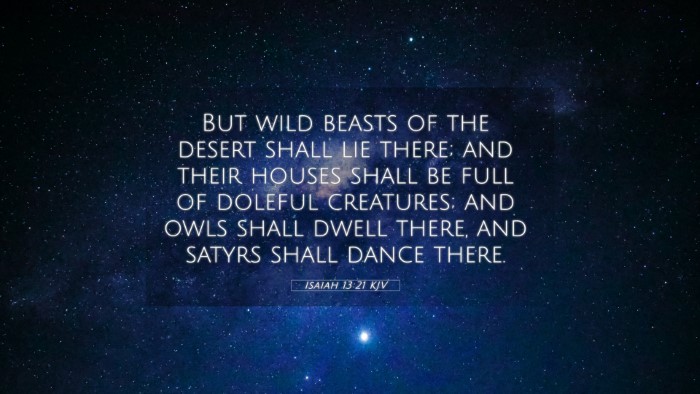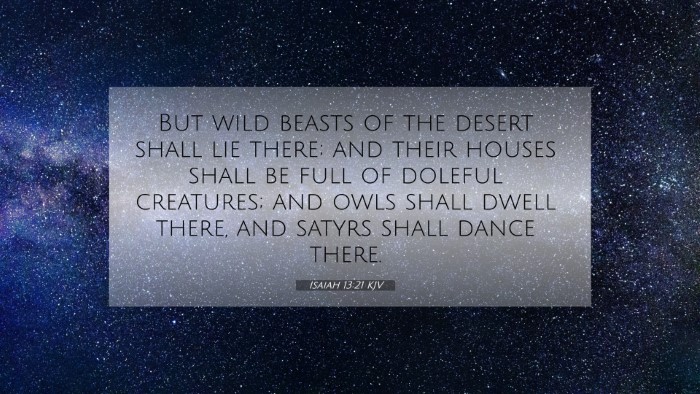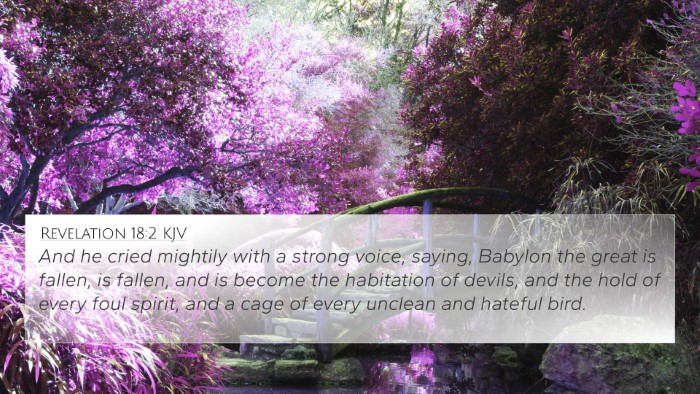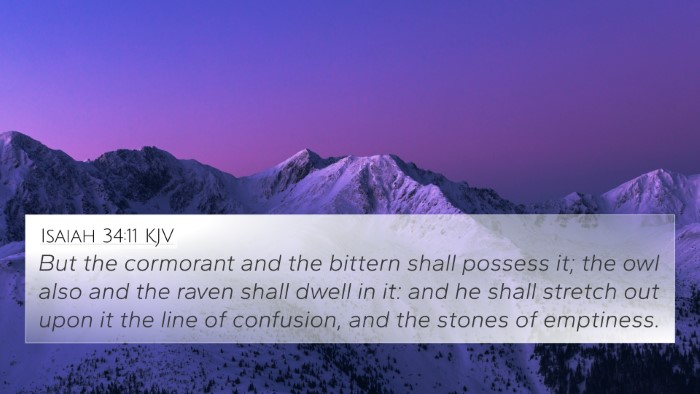Understanding Isaiah 13:21
Isaiah 13:21 states: "But wild beasts of the desert shall lie there, and their houses shall be full of owls: and ostriches shall dwell there, and satyrs shall dance there." This verse is a part of a prophetic passage warning of the destruction and desolation that would come upon Babylon.
Contextual Overview
In this chapter, the prophet Isaiah foretells the fall of Babylon, emphasizing how a once-great city will descend into desolation. The imagery of wild beasts and desolate creatures taking habitation in the city starkly illustrates the dramatic change from civilization to wilderness.
Commentary Insights
- Matthew Henry: Henry points out that the use of "wild beasts" emphasizes the total abandonment of Babylon. The flourishing civilization will be replaced by a lost wilderness, symbolizing a collective judgment upon the people for their sins.
- Albert Barnes: Barnes elaborates on the phrase "wild beasts of the desert" to indicate the state of utter desolation that will befall Babylon. He notes that such imagery underlines the fate of cities that turn away from God, becoming uninhabitable and a place for creatures rather than people.
- Adam Clarke: Clarke shifts focus to the animals mentioned. He explains that owls, ostriches, and satyrs signify spiritual desolation. The poignant imagery shows how the once-bustling city will morph into a domain of ill omens and prophetic fulfillment.
Thematic Connections
This verse encapsulates the theme of divine judgment seen throughout the Book of Isaiah. It echoes the broader Biblical principle that nations and individuals will reap what they sow.
Bible Verse Cross-References
- Isaiah 34:11: "But the cormorant and the bittern shall possess it; the owl also and the raven shall dwell in it." - This verse gives a similar vision of wilderness taking over a city.
- Revelation 18:2: "And he cried mightily with a strong voice, saying, Babylon the great is fallen, is fallen, and is become the habitation of devils, and the hold of every foul spirit." - A New Testament echo of Babylon's fall and desolation.
- Jeremiah 50:39: "Therefore the wild beasts of the desert with the wild beasts of the islands shall dwell there..." - Represents the same prophetic warning against Babylon.
- Zephaniah 2:15: "This is the rejoicing city that dwelt carelessly, that said in her heart, I am, and there is none beside me." - Highlights the irony of a great city falling to desolation.
- Micah 1:8: "Therefore I will make a wailing like the dragons, and mourning as the owls." - Similar use of owl imagery regarding desolation.
- Matthew 12:43-45: "When the unclean spirit is gone out of a man..." - Comparison of spiritual desolation leading to a worse state, linking back to the state of Babylon.
- Psalm 102:6: "I am like a pelican of the wilderness: I am like an owl of the desert." - Directly connects the emotional desolation to physical imagery of owls.
Inter-Biblical Dialogue
The verse serves as a critical juncture in the dialectic of prophecies regarding judgment and restoration. It initiates a dialogue between the Old Testament warnings of divine justice and the New Testament revelations of hope in Jesus Christ. By understanding the weight of such desolation through the lens of the entire Biblical narrative, one can see how Isaiah 13:21 fulfills its prophetical role. This understanding can also assist those engaged in Bible cross-reference studies to grasp thematic connections throughout scripture.
Application in Study
To deepen your study of Isaiah 13:21, consider using various tools for Bible cross-referencing. Resources like a Bible concordance or a Bible cross-reference guide can greatly enhance your insights. Employing techniques such as cross-reference Bible study can provide clarity on how verses interact.
Conclusion
Isaiah 13:21 stands as a sobering reminder of the consequences of turning away from the divine. The images of desolation not only reflect on the fate of Babylon but are a call to all to reflect on the state of their spiritual lives. The careful examination of cross-references and thematic connections enriches our understanding and promotes a profound engagement with the scripture.




